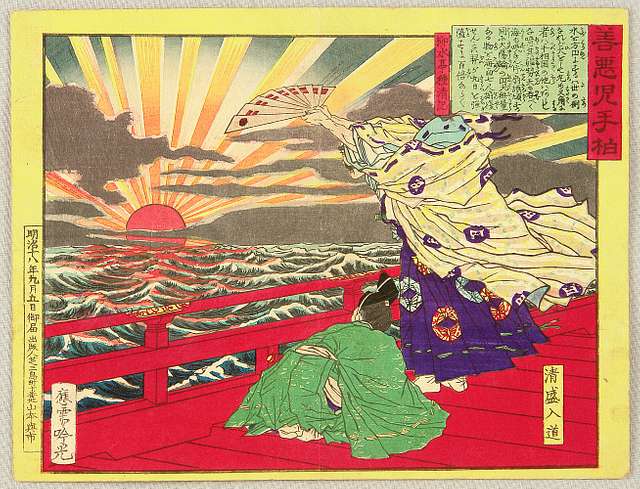Featured image from PICRYL.
Image 1: Symbols

Title: Japanese soldiers with flags in December 1937
Context: Front cover from a Japanese magazine called Sekai Gaho, which translates to Pictorial World in English. In the picture, Japanese soldiers are celebrating their victory over China in the Battle of Shanghai, which was one of the bloodiest wars in World War II.
Icebreaker prompt: Which symbols are featured in this image? In what context do they fit in? Are they still seen today?
Response: The most obvious symbol in this image is the Rising Sun Flag. The Rising Sun Flag was used by the Imperial Japanese Army, as well as the Imperial Japanese Navy, but there are slight distinctions between the two groups. In this image, the Rising Sun Flag is slightly off-center, which suggests these are soldiers of the Navy (a centered version was used by the Imperial Japanese Army). The Rising Sun Flag is uncommon to see today because it is associated with past atrocities committed by the Empire of Japan.
Another symbol in this image is the Hinomaru, which was the official flag for the Empire of Japan. The Hinomaru was not associated with Japan’s past atrocities to the same degree as the Rising Sun Flag, so it remained the national flag of Japan post-World War II and even up to the present.
Image 2: Thought Bubbles

Title: Shashin Shuho No. 151
Context: From front to back, the women are Italian, Japanese, and German elites. Their names are Francesca, Akiko, and Ursula accordingly. Each of the women are holding a hagoita (wooden paddles used in a badminton-like sport) out of respect to other leaders of the Axis powers. This image was the cover of a magazine called Shashin Shuho, which translates to Photograph Weekly Report in English. This issue was published in January 1941.
Icebreaker prompt: Analyze the image and create a thought bubble for each of the women.
Response:
Francesca: “I can’t believe I’m holding a picture of this jerk. Him and Mussolini dislike each other.”
Akiko: “I hope these women like Japan!”
Ursula: “What is Akiko wearing? I’ve never seen anything like that in Germany before… it’s so different.”
Image 3: Questioning

Title: Shashin Shuho No. 189
Context: These are Japanese soldiers fighting in the Battle of Changsha, which was fought in 1939 and resulted in Chinese victory. This image was the cover of a magazine called Shashin Shuho, which translates to Photograph Weekly Report in English. This issue was published in August 1941.
Icebreaker prompt: Brainstorm at least three questions about this image and arrange them in order of curiosity.
Response:
How were they able to edit the coloring of this image to make the Hinomaru stand out? Image editing was primitive back then, so I’m curious how they did this.
Why would Shashin Shuho feature an image of a battle that Japan lost? It seems counterintuitive to feature an image for a shameful defeat, so there might be a propagandistic twist.
What is beyond the smokescreen? I wonder how staged this image is, or if there were actually enemy troops downrange?


A fascinating collection of cover images. Seems like you have some background on the subject. Your use of icebreakers is very creative. Clever comments from the women and interesting questions raised in image 3.
The fact that the last came from Aug 1941 – the eve of Pearl Harbor is especially interesting to think about. Makes me wonder if the the Pearl Harbor attack plan was being debated in Japan about the time it was published.
A very engaging and novel activity.
A truly impressive post, Matt! It’s fascinating to consider the differences in representations of Japan’s flag pre/post WW2. The photos that you chose provide engaging examples of propaganda that would give your students an opportunity to see some of the mechanisms that drove WW2 in a unique way.
Matt! Your context for each image is so detailed, it shows how much knowledge you have of this subject and time period. Your analysis of the images is also very in-depth. The photos you chose are incredibly interesting, especially the second one with the young women. The color emphasis across each photo also draws some similar themes throughout the images. Great work!